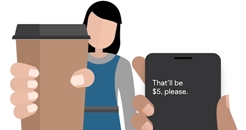 9 useful apps for people who are deaf or have hearing loss
9 useful apps for people who are deaf or have hearing loss
From a blog by AbilityNet
There are multiple communication options used by people who are deaf or who have hearing loss. And, in the last five years, advances in automatic speech recognition (ASR) have opened up further options. Across the UK, 11 million people are currently affected by deafness or hearing loss, according to the charity Action on Hearing Loss. As the population ages, more people are expected to be affected.
Here are some of the latest tech options available for communication, leisure and education for people who have hearing loss:
Google Live Transcribe
Google's recent release Live Transcribe uses ASR technology to offer real-time transcription of speech into text. The spoken text is picked up by a phone microphone and delivered to an android phone screen using wifi or another network connection. The tech works for 70 different languages.
AVA
Lip reading can be harder in a group of people and this is one of the main reasons AVA was created. If a person who is deaf or who has hearing loss is with a group of friends, they can get those friends to connect to the app - then the person(s) who has hearing loss will see live transcriptions of the group conversation.
Rogervoice
Rogervoice is an app which produces live transcription during phone calls in more than 100 different languages. People who are deaf and those who have hearing loss, or someone who has difficulty speaking can use the phone to have a conversation with someone, and receive a typed text (on their phone) of what the other person is saying.
Voxsci
Voxsci is a speech-to-text app which translates voicemail messages into texts and emails which can be saved, searched and shared.
TapSOS
Offers a way for people who are deaf and those who have hearing loss to communicate with emergency services without needing to speak or listen. TapSOS is very visual and works by the user tapping the screen to select which options they need.
Braci Sound Alert
Braci Sound Alert app lets you record the sounds in your environment and then gives you visual and vibrational alerts on your smartphone when it recognises them. For example, it can alert you when an alarm goes off or when a doorbell rings.
Signly
It might be assumed that written information is the best way to communicate with people who are deaf. It’s not always understood by the general population that learning to read means connecting what a word looks like to how it sounds and so reading can be more difficult for people who are born deaf, particularly when that person is still a child. The Signly app was first used at the Roald Dahl museum in the UK. Visitors to the museum point their phone at exhibits and are offered videos on their smartphone which display sign language descriptions of the exhibitions.
Your local cinema app
A simple website and app which lets you know films at your local cinemas which are showing with subtitles and audio description options.
Subtitles Viewer! / Sub
Using your phone microphone, the Subtitles Viewer app enables you to view subtitles in various languages on your iOS device. The app synchronises with television or movies on your TV or at the cinema. There are other similar options on Android available.
Read full blog here.
Retweet about this article:
From a blog by AbilityNet, 04/06/2019